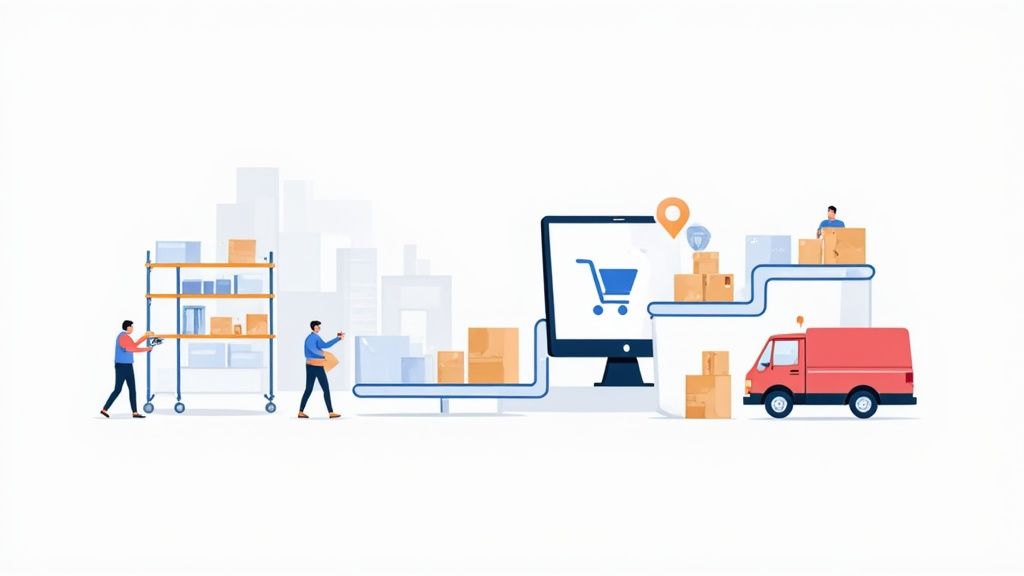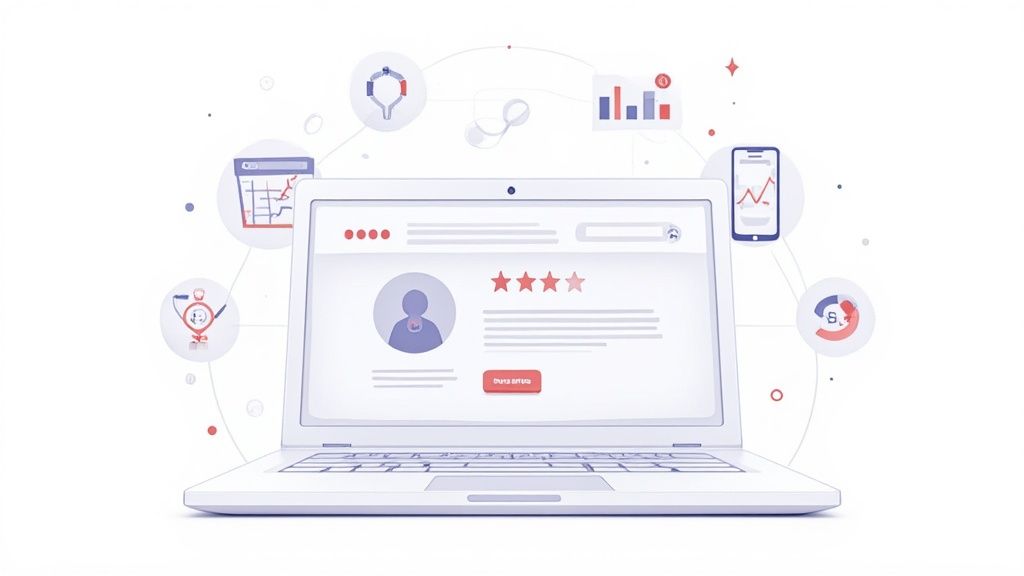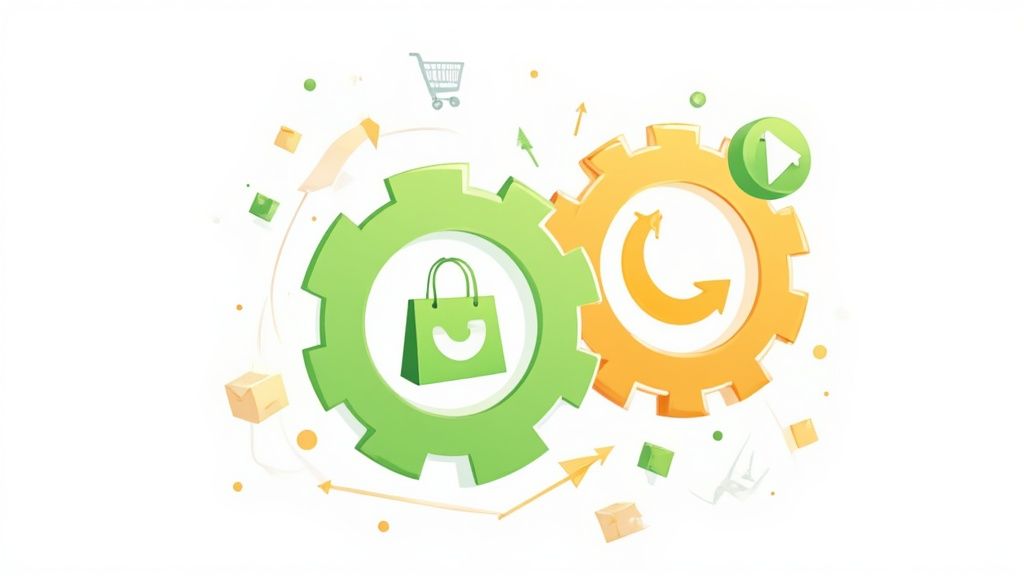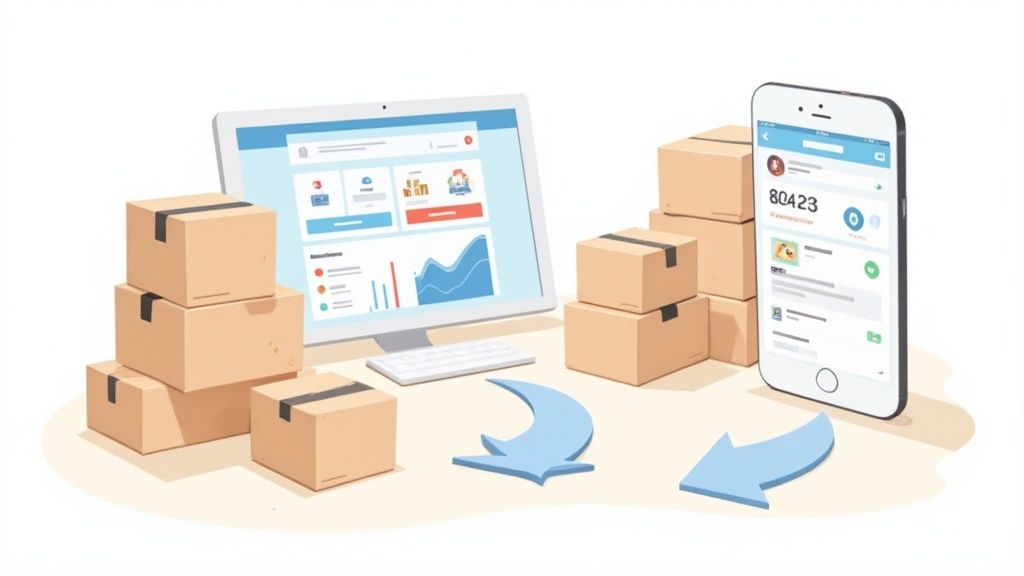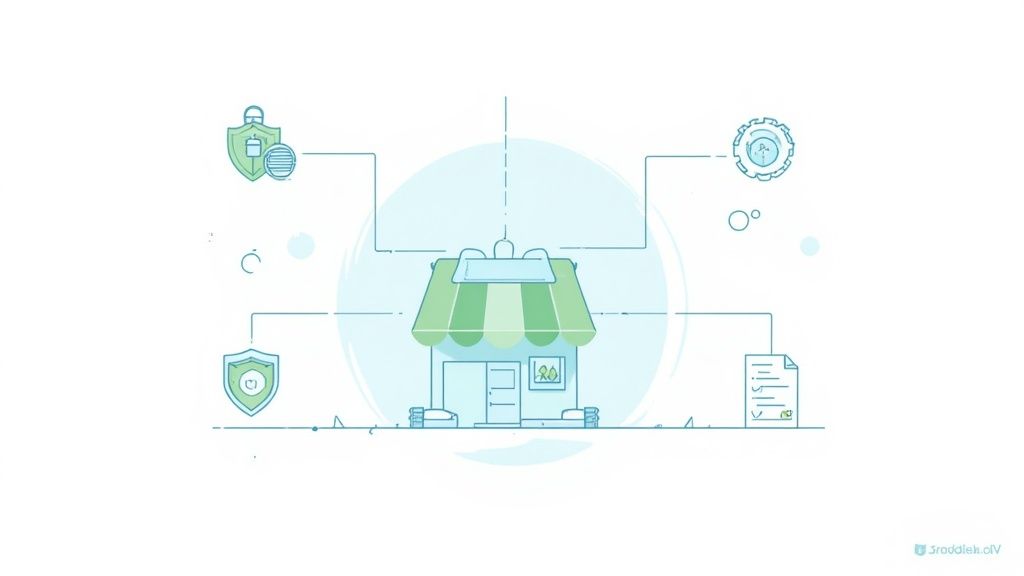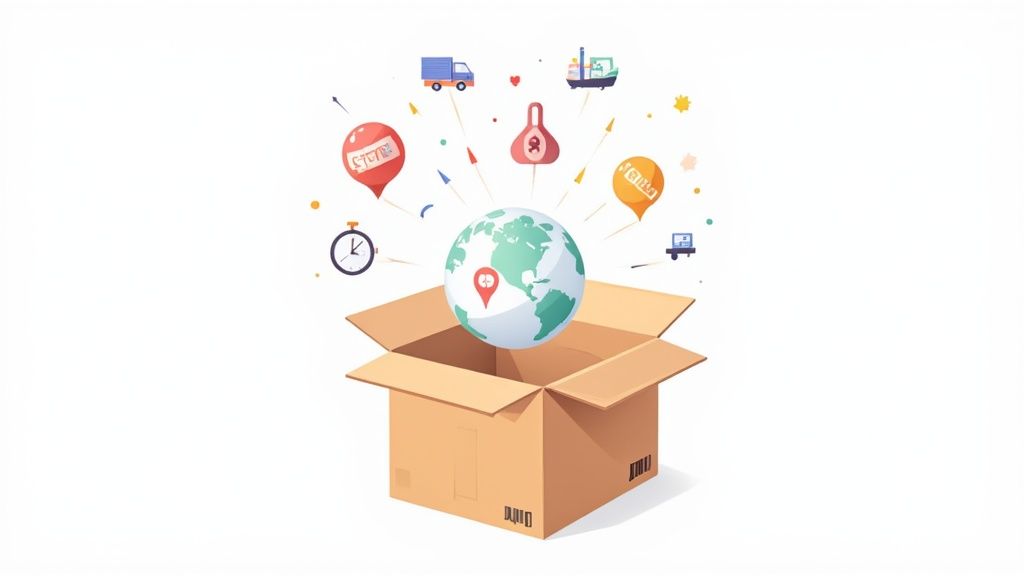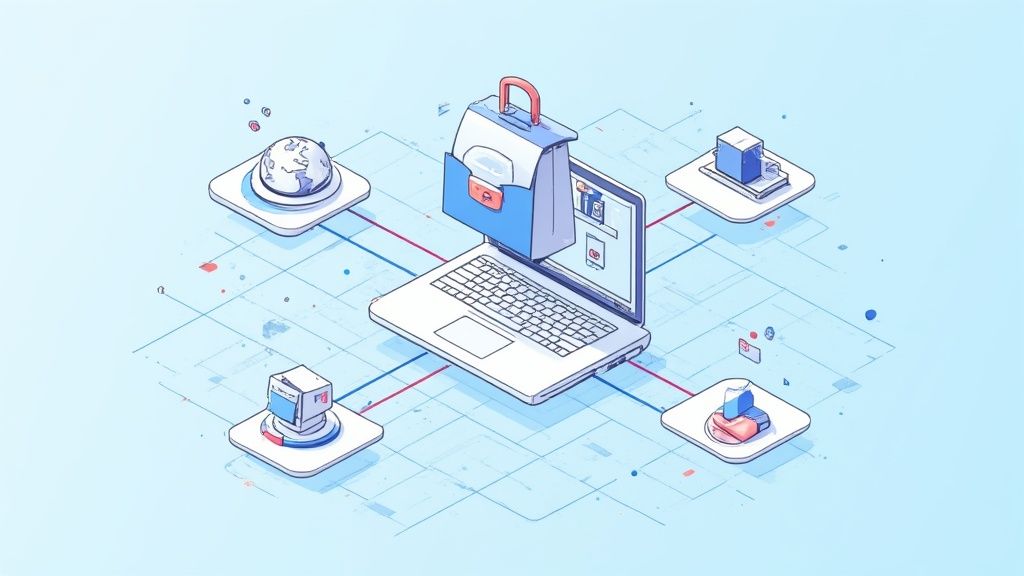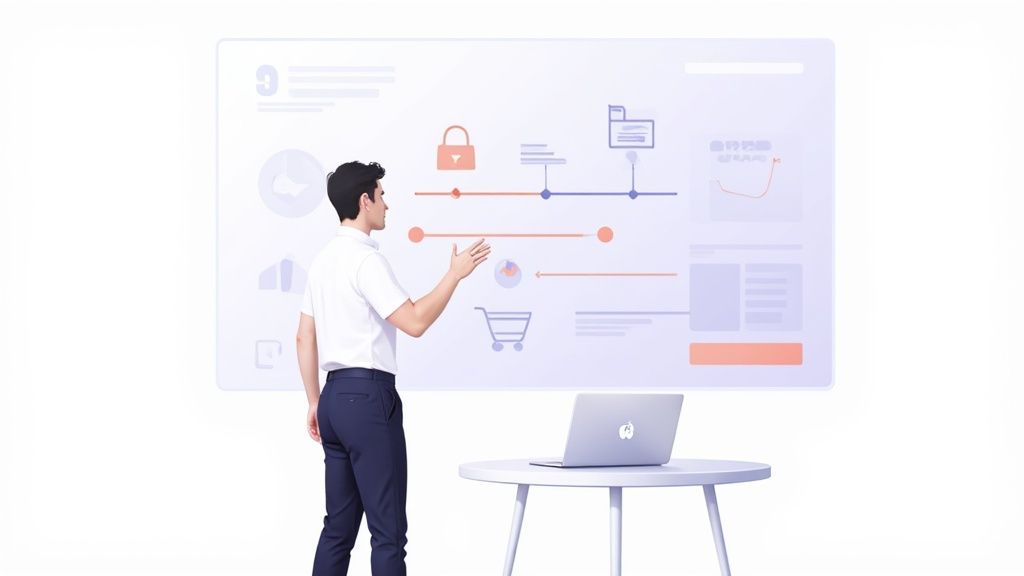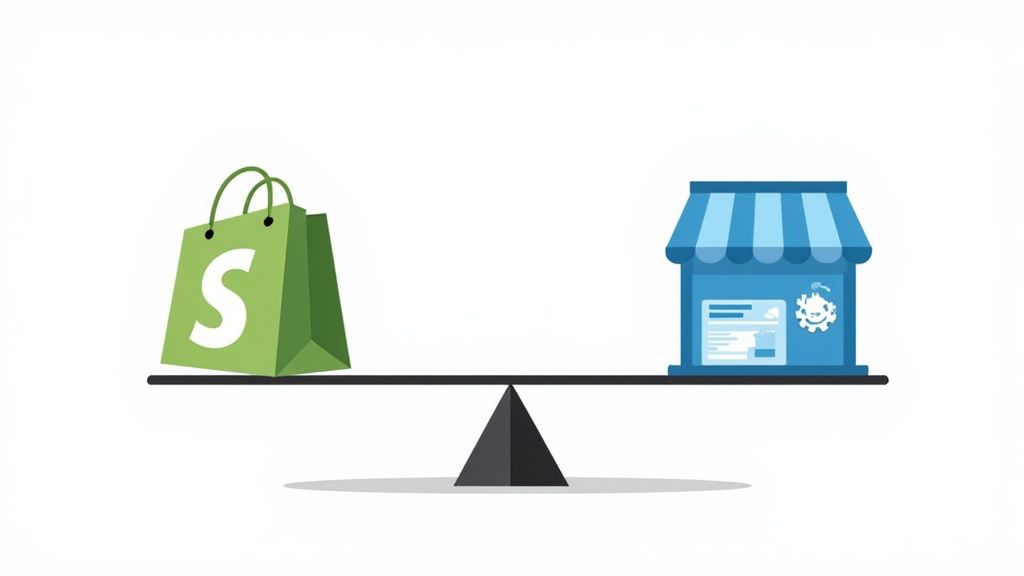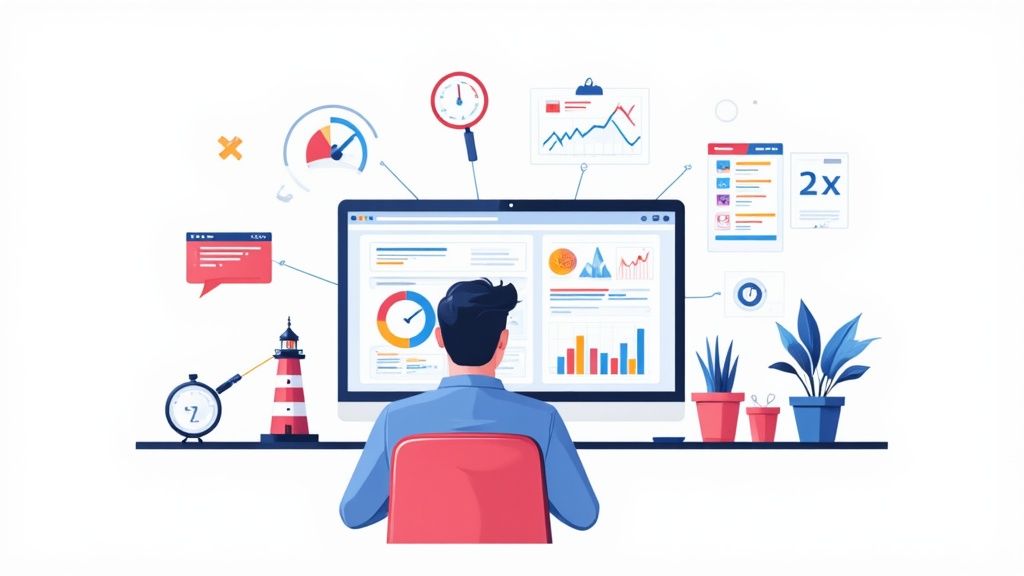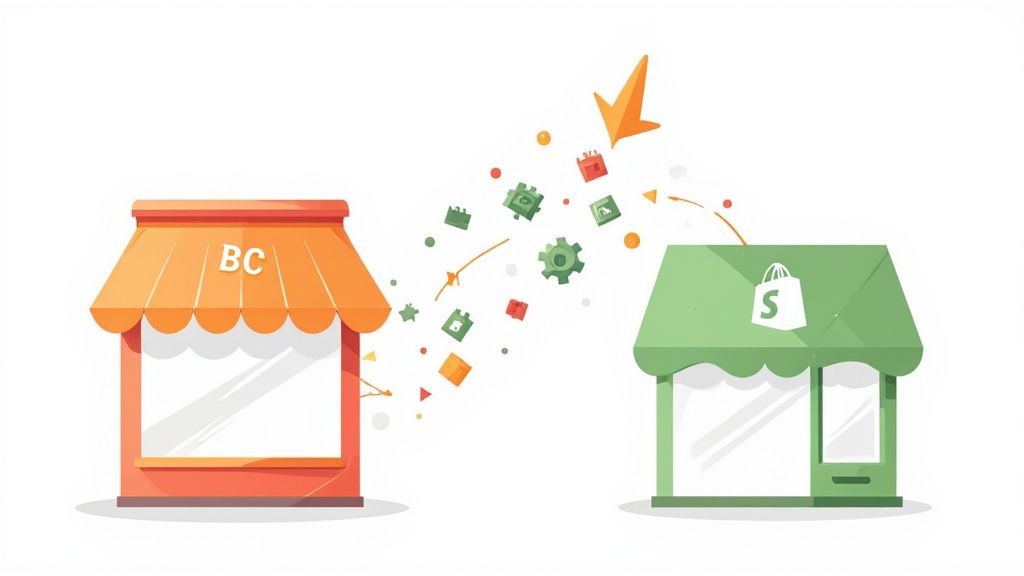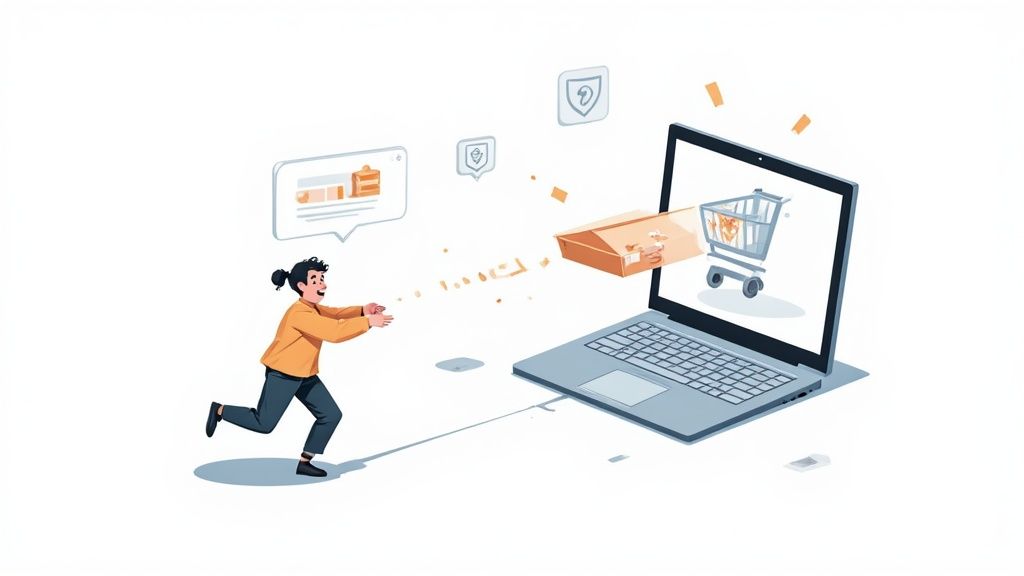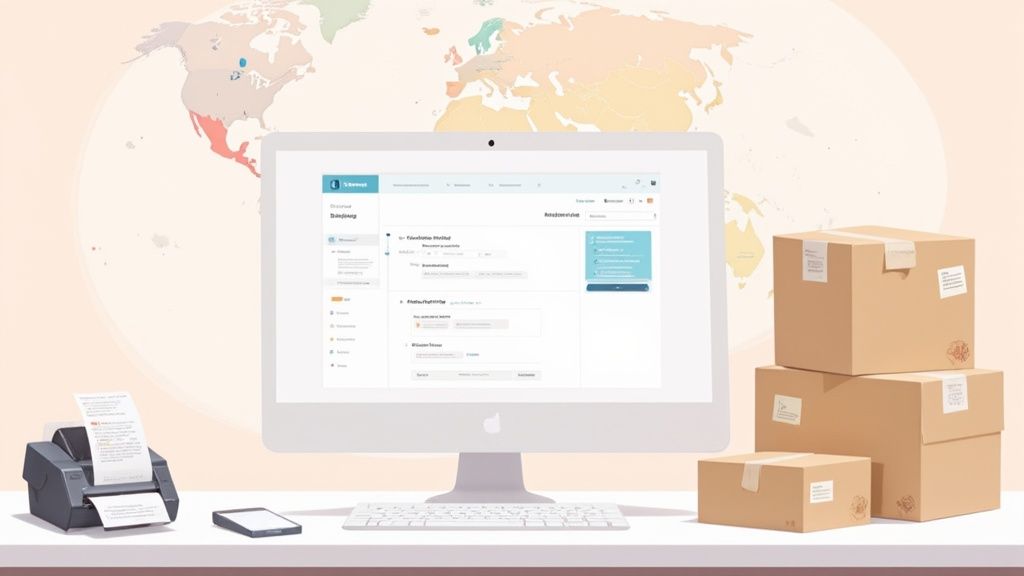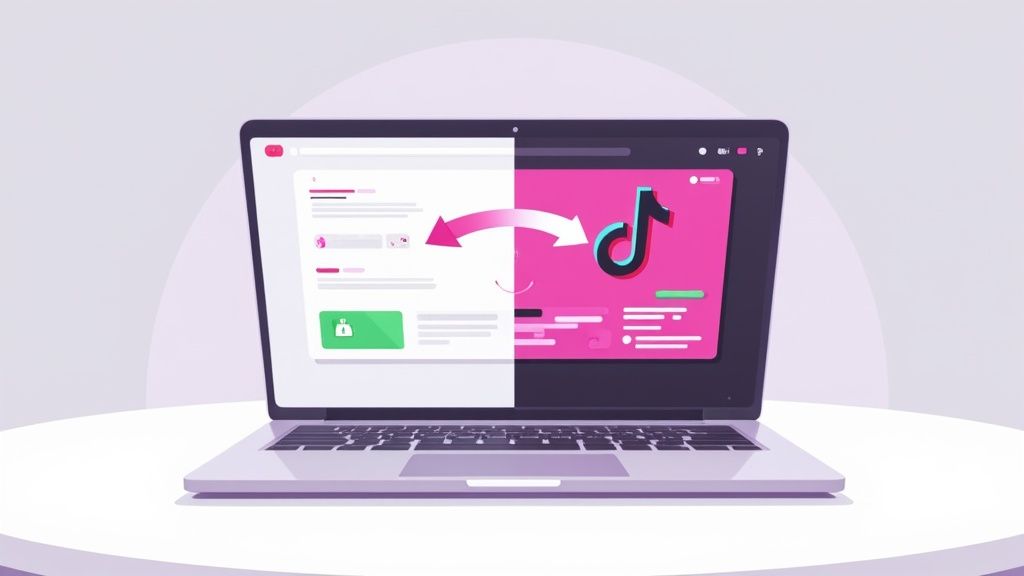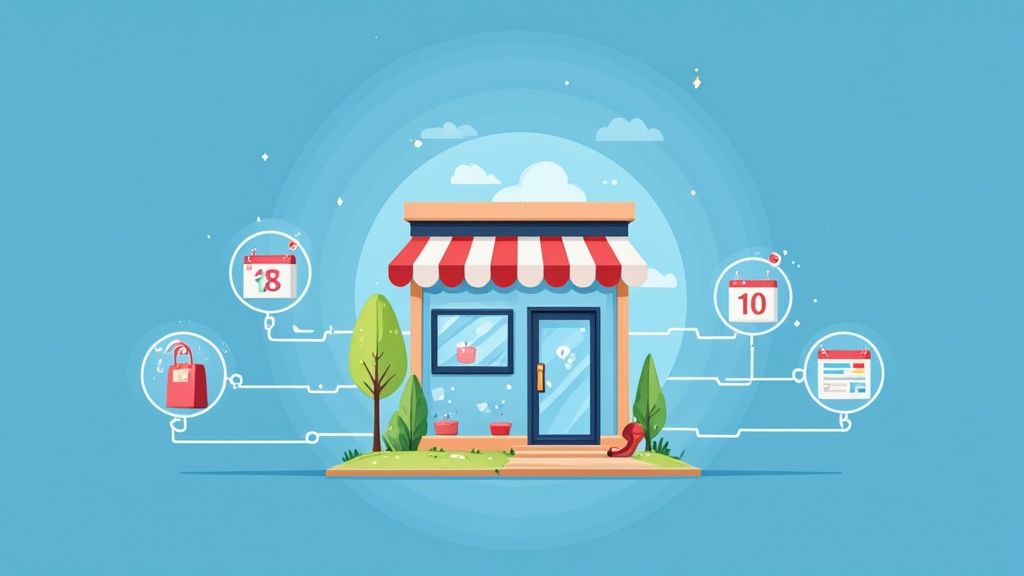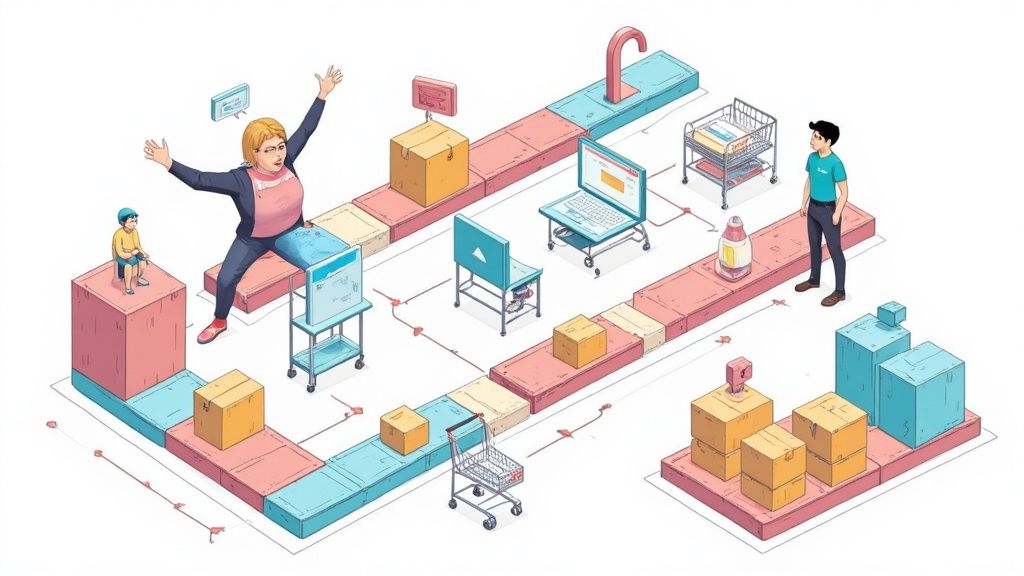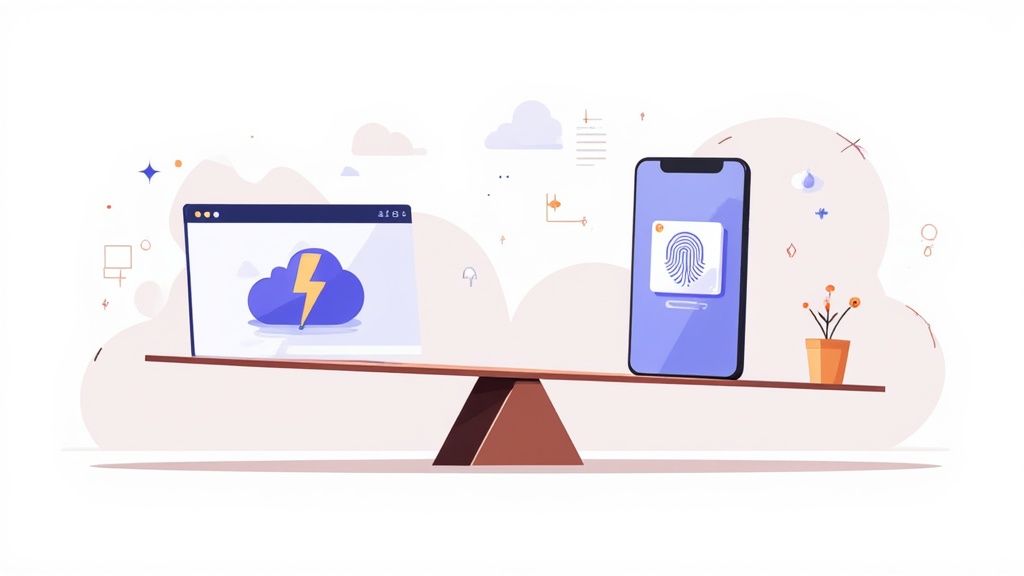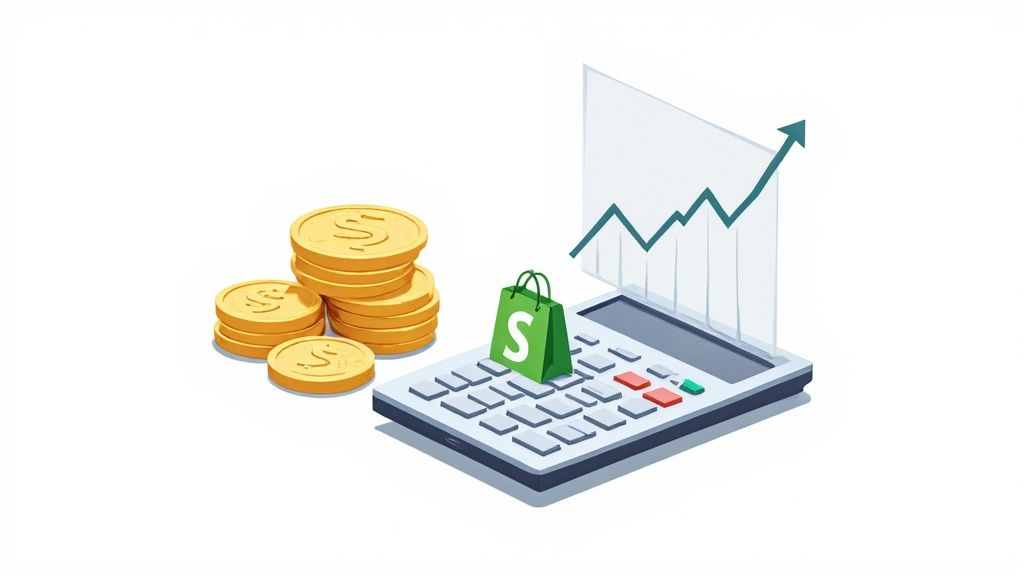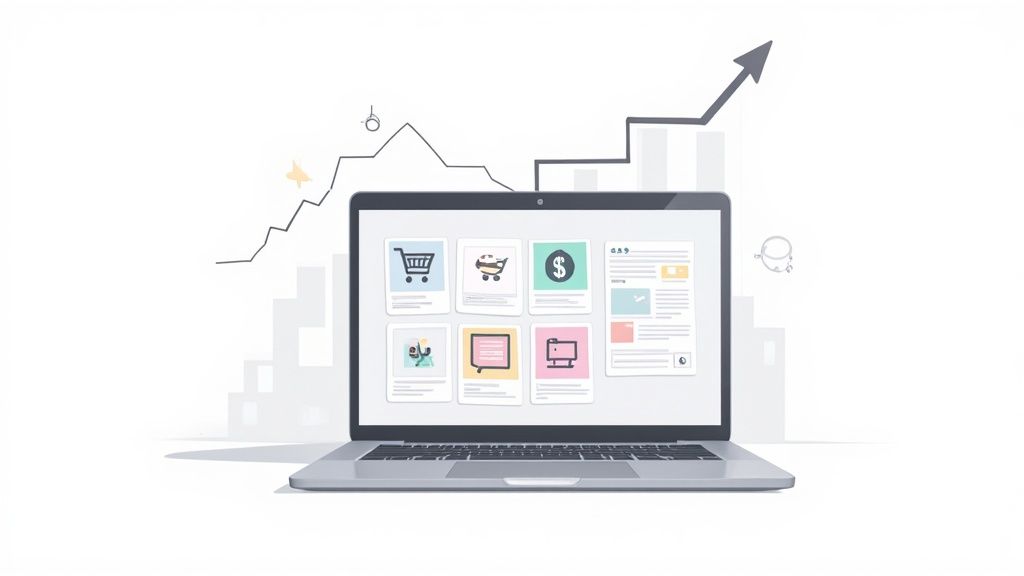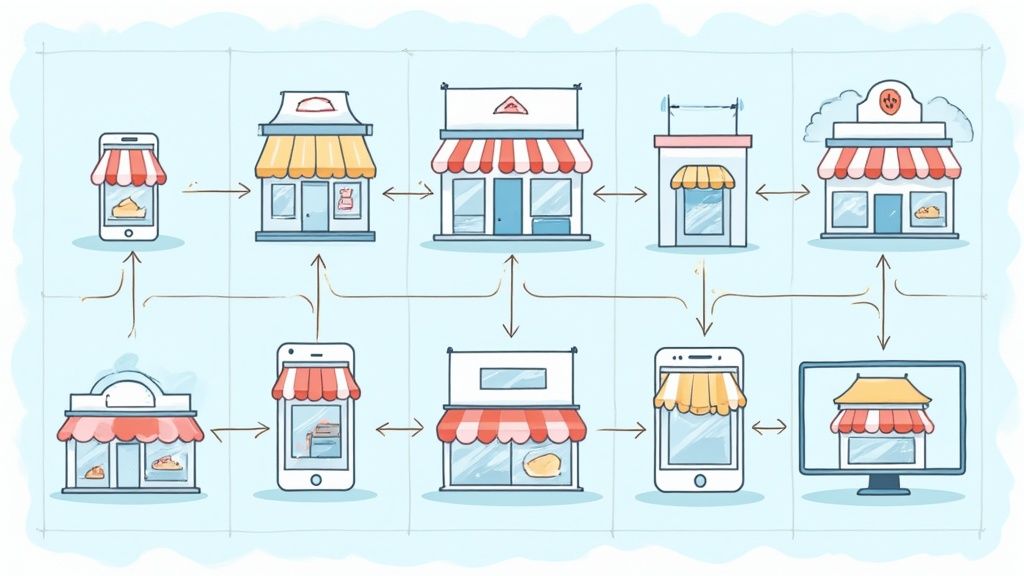
An order management system (OMS) is a fancy name for the digital brain behind your entire sales operation. It’s the one piece of software that tracks sales, orders, inventory, and fulfillment all in one place.
Think of it as the central nervous system for your business. It connects every part of an order's journey, making sure everything runs smoothly from the second a customer hits "buy" to the moment the package lands on their doorstep.
The Conductor of Your eCommerce Orchestra

Imagine trying to lead a massive orchestra where every musician is in a different room. You've got your sales channels (the violins), inventory management (the brass section), warehouse teams (percussion), and customer service (the woodwinds). Without a conductor, you'd just have a bunch of noise. Missed cues, wrong notes... a total mess.
An OMS is that conductor. It doesn't just process orders; it brings the whole performance together. It becomes the single source of truth, making sure every department is playing from the same sheet of music in real-time.
Unifying Every Step of the Order Lifecycle
The moment a customer places an order, the OMS kicks into high gear. It instantly checks inventory levels across all your sales channels—whether that's your Shopify store, a marketplace like Amazon, or even a brick-and-mortar shop. This simple step prevents the dreaded oversell and the customer frustration that follows.
Once the order is confirmed, the OMS gets smart. It routes the order to the best possible fulfillment center based on a few key factors:
- Customer Location: It finds the closest warehouse to cut down on shipping times and costs. No one likes waiting.
- Inventory Levels: It picks a location that actually has everything in stock to fulfill the order in one go.
- Warehouse Capacity: It avoids sending orders to a facility that's already swamped, keeping your operations flowing.
An OMS transforms a clunky, disconnected set of tasks—taking an order, checking stock, picking and packing, shipping, and sending updates—into a single, automated, and intelligent workflow. It replaces manual guesswork with data-driven precision.
Powering Growth and Customer Satisfaction
This synchronized approach is absolutely critical if you want to grow. As your business scales, trying to manage orders manually becomes a recipe for disaster. You get errors, delays, and a ballooning budget for operations.
It's no surprise the demand for these systems is exploding. As of 2023, the global OMS market was valued at USD 3.2 billion and is on track to nearly double to USD 6.1 billion by 2032. You can dig into the specifics of this OMS market growth on dataintelo.com.
An effective OMS gives you the solid foundation you need to handle more orders without dropping the ball on accuracy or speed. For any ambitious eCommerce brand, it's not just a nice-to-have; it’s essential.
The Core Functions of an Order Management System
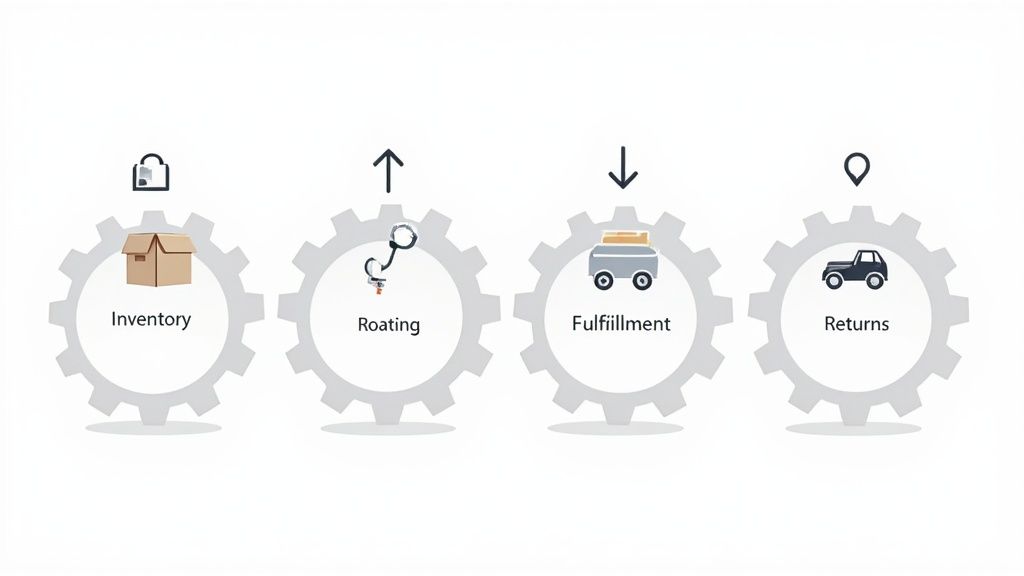
To really get what an order management system does, you have to pop the hood and look at its core functions. These aren't just isolated features; they're interconnected gears that work together to turn the messy, complex order lifecycle into a smooth, well-oiled machine.
Think of it like a highly skilled pit crew for your eCommerce brand. Each member has a specific job, but they all work in perfect sync to get the car—your customer’s order—back on the track as quickly and accurately as possible. Let’s break down the key players on this team.
To give you a clearer picture, here’s a quick rundown of the essential functions you'll find in a modern OMS and why they matter for your business.
Each of these components plays a vital role in creating an efficient, customer-friendly operation. Let's dig a little deeper into how some of the most critical functions work in practice.
Centralized Inventory Management
This is the absolute foundation of a good OMS. It creates a single, unified view of your inventory across every single place you sell and store products—your Shopify store, Amazon listings, retail locations, and all your different warehouses.
By syncing stock levels in real time, it virtually wipes out the risk of selling a product that’s already been snapped up on another channel. This is crucial for keeping customers happy and avoiding those painful "oops, it's out of stock" emails. To dive deeper, check out our guide on automated inventory management systems.
An OMS acts as your business's single source of truth for inventory. When a product is sold anywhere, the system updates the available count everywhere, instantly.
Automated Order Processing and Routing
As soon as a customer clicks "buy," the OMS jumps into action, automating what comes next. It intelligently routes the order to the most logical fulfillment center or warehouse based on a set of rules you define.
This logic can weigh factors like:
- Geographic Proximity: Sending the order from the warehouse closest to the customer to slash shipping costs and speed up delivery.
- Stock Availability: Making sure the chosen location has every item in the order ready to go.
- Shipping Carrier Rules: Picking a fulfillment center that can meet specific shipping needs or carrier pickup times.
This automation gets rid of hours of manual work, cuts down on human error, and gets orders into your fulfillment team's hands in a fraction of the time.
Fulfillment and Shipping Coordination
Once the order is routed, the OMS communicates directly with your warehouse management system (WMS) or third-party logistics (3PL) partner. It zaps over all the necessary info—picking lists, packing slips, and shipping labels—to get the pick, pack, and ship process rolling.
This seamless connection gives you total visibility from start to finish. You can watch an order's status change from "processing" to "shipped" and automatically trigger tracking notifications to the customer, drastically improving their post-purchase experience.
The power of these integrated functions is why huge companies, with their sprawling supply chains, held a massive 52.45% revenue share in the multichannel order management market back in 2023. But it’s not just a game for the big players. Small and medium-sized businesses are the fastest-growing segment, proving that brands of all sizes are waking up to how vital these tools are. You can explore more insights on this trend in the multichannel order management market report on straitsresearch.com.
Why Your Business Needs an Order Management System
Knowing what an order management system does is one thing, but understanding the real-world impact it can have on your bottom line is another thing entirely. Without one, growing brands inevitably hit a wall. Manual processes start to crack under the pressure, leading to expensive mistakes, unhappy customers, and a team that’s constantly fighting fires instead of building the business.
An OMS isn't just another piece of software on the pile; it’s a complete overhaul of your operational engine. It takes the chaotic mess of spreadsheets and disconnected data and consolidates it into a single command center. This is where features stop being just features and start delivering tangible, game-changing results.
Think about a classic scenario for a scaling brand: a customer orders an item that your website says is "in stock," but your team later finds out it was sold on another marketplace just minutes before. Right away, you've created a negative experience. Now you're scrambling to fix it with manual follow-ups, apology emails, and maybe even a refund. An OMS makes this entire problem vanish by giving you real-time inventory visibility across every single channel, making sure you only sell what you actually have.
Drive Efficiency and Reduce Costly Errors
Manual order processing is a recipe for human error. One tiny typo in a shipping address or the wrong SKU punched in can snowball into a massive headache involving returns, reshipments, and wasted inventory. Automation is the only real solution. An OMS automates the whole order lifecycle, from the moment an order is placed to processing, routing, and fulfillment communication.
This switch to automation pays off in big ways:
- Fewer Shipping Mistakes: By automatically checking addresses and pushing the correct order data to your warehouse, an OMS slashes the rate of incorrect shipments.
- Increased Team Productivity: It frees up your team from the soul-crushing work of manual data entry, letting them focus on things that actually move the needle—like great customer service, marketing, and strategic planning.
- Lower Operational Costs: When you have efficient fulfillment, fewer returns, and smoother workflows, it all adds up. Your cost-per-order drops, and your profit margins get a whole lot healthier.
By swapping out manual tasks for automated workflows, an OMS doesn't just improve accuracy; it builds a more scalable and resilient operation. Your business can handle a sudden spike in orders without a corresponding spike in errors.
Enhance the Customer Experience
In today's crowded market, a great customer experience is everything. Slow fulfillment, radio silence on order status, and a clunky returns process are the fastest ways to lose a customer forever. An OMS tackles these pain points head-on by creating a post-purchase journey that feels effortless for the customer.
With an OMS in place, you can send out real-time, automated updates like order confirmations, shipping notifications, and tracking information. This kind of proactive communication builds trust and dramatically cuts down on the number of "Where is my order?" emails flooding your support inbox. That improved visibility and speed are what turn first-time buyers into loyal, repeat customers who fuel your long-term growth.
How an OMS Connects to Your Tech Stack
An order management system is never a solo act. Its true magic is unleashed when it becomes the central nervous system of your entire eCommerce operation, tying everything together. Think of it as a universal translator for all the different software you rely on. It makes sure every system, from your storefront to your shipping carrier, is speaking the same language in real-time.
This constant, seamless communication is powered by Application Programming Interfaces (APIs). You can picture APIs as secure data highways that allow your OMS to plug directly into other platforms and share critical information automatically. Without this digital handshake, you're stuck with disconnected data silos, forcing your team into the soul-crushing, error-prone task of manually copying and pasting information between systems.
Creating a Unified Ecosystem
When an OMS is properly plugged into your other tools, it creates a powerful, unified ecosystem where everything just works. An order placed on your Shopify store, for example, doesn't just sit there. The OMS instantly grabs that data and sets off a chain reaction across your entire eCommerce tech stack.
This infographic perfectly illustrates how an OMS creates a positive feedback loop of efficiency, accuracy, and growth for your business.
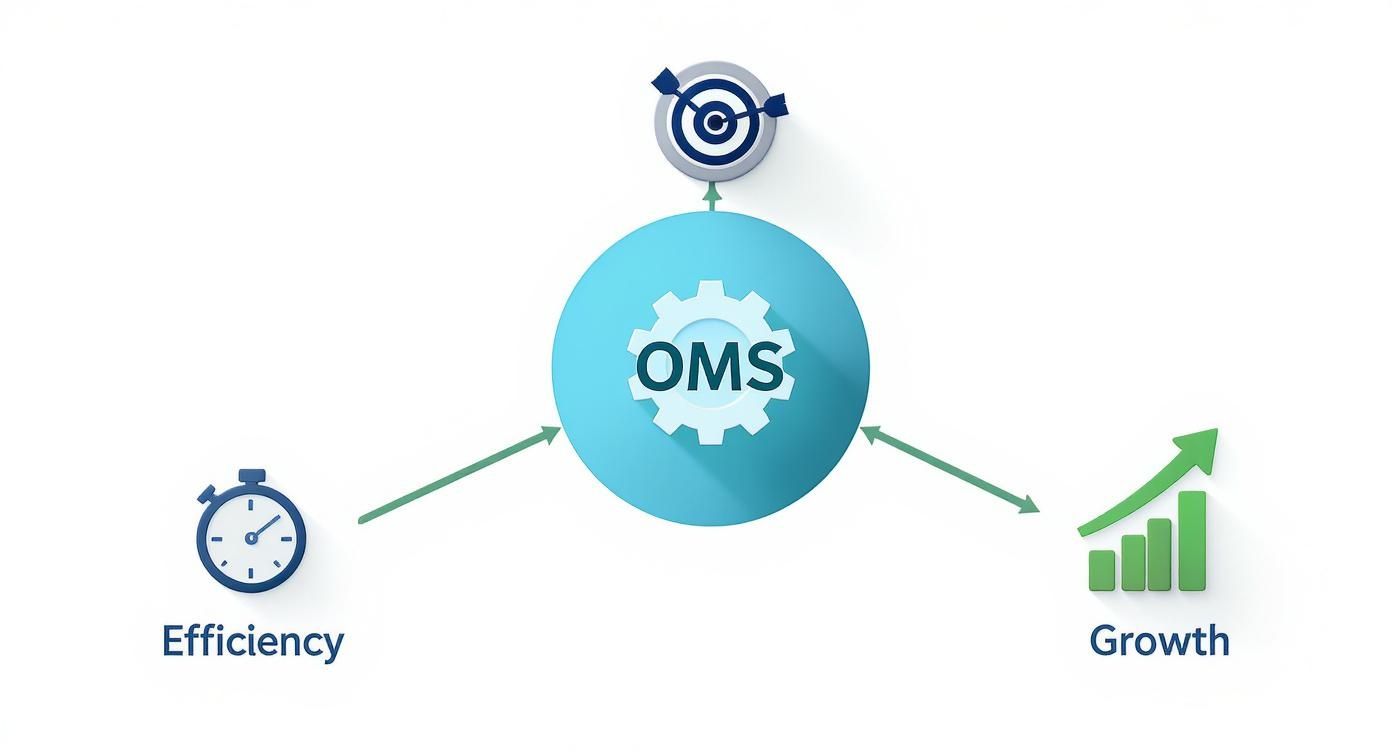
As the visual shows, these aren't just separate benefits—they're deeply interconnected, with each one reinforcing the others.
This interconnectedness means that in a split second:
- Your inventory count is updated on your Amazon and Walmart marketplace listings.
- The order details shoot over to your 3PL or warehouse management system (WMS) for picking and packing.
- Customer information gets synced with your customer relationship management (CRM) software.
- Financial data is pushed to your accounting software, like QuickBooks or Xero.
This kind of automation turns your OMS into a true command center for your entire operation.
A well-integrated OMS isn't just about efficiency; it's about creating a single source of truth. It ensures that the data you see in your inventory system perfectly matches what's in your sales channels and what's in your accounting software, eliminating manual reconciliation for good.
For an OMS to really perform within this larger ecosystem, it all comes down to the architecture. Applying solid software architecture design patterns is what allows for scalable and maintainable integrations. This foundational approach is what ensures your systems can grow and adapt with your business without everything falling apart.
The Future of Order Management with AI

The old-school order management system is getting a serious upgrade. What used to be a fairly reactive tool for just processing orders is now morphing into the proactive, intelligent brain of the entire supply chain, all thanks to Artificial Intelligence (AI) and machine learning.
Think of it this way: your OMS is no longer just a conductor following the music. It’s becoming the composer, anticipating needs and fine-tuning operations before problems can even crop up.
This isn't just a trend; the numbers back it up. The global order management market was valued at an estimated USD 3.7 billion in 2024 and is on track to hit USD 7.5 billion by 2031. This explosion is being fueled by the nonstop growth of eCommerce and the infusion of tech like AI and predictive analytics. You can discover more about the growing OMS market on 6wresearch.com.
This leap from a reactive to a predictive model is exactly where the future of order management is headed.
Intelligent Demand Forecasting
One of the most powerful ways AI is changing the game is through demand forecasting. Instead of just looking at last year's sales figures, AI algorithms can crunch a mind-boggling amount of data. We’re talking market trends, competitor pricing, social media chatter, and even weather patterns to predict what customers will buy and when.
This gives businesses a massive leg up, allowing them to:
- Optimize Inventory Levels: You can stock up on hot items right before a demand spike and avoid getting stuck with shelves of products nobody wants.
- Improve Marketing ROI: Align your promotions with predicted waves of customer interest for way more bang for your buck.
- Prevent Stockouts: Keep products on the shelves during peak seasons, which protects both your revenue and your hard-won customer loyalty.
With AI, forecasting moves from an educated guess to a data-driven science. The OMS becomes a strategic tool that helps you stay several steps ahead of customer behavior, not just react to it.
Smart Order Routing and Automation
AI is also completely overhauling how orders get from your warehouse to your customer's door. Smart algorithms can now analyze countless factors in real-time to pinpoint the most efficient and cost-effective fulfillment path for every single order.
And this goes way beyond just picking the warehouse that's geographically closest. An AI-powered OMS can weigh variables like shipping carrier costs, promised delivery speeds, warehouse staffing levels, and even potential transit delays to make the smartest call in an instant.
This automated intelligence ensures every single order is fulfilled in the absolute best way possible, which slashes your shipping costs and thrills customers with faster delivery times. It’s a win-win.
Choosing the Right Order Management System
Picking the right order management system isn't about finding the software with the longest feature list. It’s about diagnosing your specific operational headaches and finding a solution that fits your business like a glove—not just for today, but for where you're headed.
The wrong choice can lock you into clunky workflows and endless manual workarounds. But the right one? It becomes the engine for your growth.
Before you even book a demo, take a hard look at your own operations. Start by identifying your biggest pain points. Are you constantly overselling your most popular products during a flash sale? Are surprise shipping costs eating away at your profit margins? Is your team drowning in a sea of spreadsheets, manually entering order data?
Pinpointing these issues first turns your search from a vague "we need a system" into a focused mission. This clarity is your best defense against flashy sales pitches that don't actually solve your core problems.
Key Factors to Evaluate
Once you know exactly what you’re trying to fix, you can start evaluating potential systems with a clear checklist. After all, a system that works wonders for a small marketplace seller might completely crumble under the pressure of a rapidly growing DTC brand.
Focus on these non-negotiables:
- Scalability: Can the system handle a massive surge in orders during Black Friday without breaking a sweat? You need a platform that’s built to grow with you, not hold you back when you hit your stride.
- Integration Capabilities: Your OMS has to play nicely with your existing tech. That means seamless, real-time connections to your eCommerce platform (like Shopify), your accounting software, and your 3PL partners. Flawless API connections are an absolute must.
- Customization and Flexibility: Can you set up custom order routing rules that match your unique fulfillment strategy? A one-size-fits-all approach is a recipe for inefficiency for ambitious brands.
A truly effective OMS doesn't just manage orders; it orchestrates your entire fulfillment network. It should provide the visibility and intelligent automation needed to turn your logistics from a cost center into a competitive advantage.
Ultimately, your choice will likely boil down to two main types: on-premise solutions you host yourself, or cloud-based SaaS platforms. For the vast majority of eCommerce brands, the agility, lower upfront cost, and hands-off maintenance of a SaaS model is the clear winner.
Here’s a quick breakdown of why that is.
On-Premise vs. Cloud-Based (SaaS) OMS Comparison
Deciding between hosting your own system versus using a subscription-based service is a major fork in the road. On-premise solutions give you total control but come with the heavy lift of managing all the hardware and IT yourself. Cloud-based systems, on the other hand, offer a much more hands-off approach that lets you focus on your business, not on server maintenance.
This table lays out the key differences to help you see which path makes the most sense for your brand.
For most modern eCommerce businesses, the choice is pretty clear. The ability to get started quickly, scale on demand, and access your system from anywhere without needing a dedicated IT department makes the SaaS model the go-to option for brands focused on growth.
Got Questions? We've Got Answers
Let's tackle some of the most common questions that pop up when brands start thinking about getting a real order management system in place.
Is an Order Management System Just for the Big Guys?
Not at all. While massive companies absolutely depend on them, an OMS is a game-changer for any small or medium-sized business that's serious about growth.
Think about it: if you're juggling orders from your website and maybe a marketplace or two, or if your team is burning hours manually punching in data, you're already feeling the pain. An OMS steps in to automate that grind and stop costly mistakes before they happen. It’s for anyone who wants to scale without the chaos.
How Long Does It Take to Get an OMS Up and Running?
The timeline really depends on how complex your business is. For a small brand plugging a straightforward OMS into a Shopify store, you could be looking at just a few weeks.
But for a bigger operation—we're talking multiple warehouses, international shipping, and linking up to an ERP system—it's more of a months-long project. You need to make sure every piece of your tech stack is talking to each other perfectly.
The real goal isn't just to "turn it on." It's to make sure the system truly understands your unique business rules for routing and shipping orders. That initial setup time is an investment that pays off big time.
What's the Typical Price Tag for an Order Management System?
The costs can swing wildly, but most modern systems are cloud-based (SaaS), meaning you'll pay a monthly subscription that usually grows with your order volume.
- For smaller businesses just starting out, you might find entry-level plans beginning at a few hundred dollars a month.
- For high-growth brands needing the works, expect to invest several thousand dollars monthly. This gets you the advanced stuff like complex automation rules, demand forecasting, and a dedicated support team.
The trick is to stop thinking of it as a cost and see it as an investment. The time you save, the errors you eliminate, and the happy customers you create almost always deliver a massive return by cutting your operational overhead and protecting your hard-earned revenue.
Ready to build an eCommerce operation that's built for growth, not headaches? ECORN specializes in creating scalable Shopify solutions that integrate powerful tools to streamline your business. Discover how our Shopify expertise can optimize your operations.







